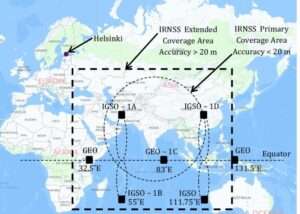CSIP: PRELIMS BOOSTER SERIES -173 SCIENCE AND TECHNOLOGY
NVS 01 in NAVIC
NAVIC
It is an independent regional satellite navigation system that provides accurate real-time positioning, navigation and timing services.
COVERAGE
Primary Service Area: Covers entire Indian mainland and 1500km around it with positioning accuracy of about 20 metres or lesser
Extended Service Area: Lies beyond primary service area, covering half of Africa, Australia and area between them with positioning accuracy > 20m
SERVICES
2 types of services
Standard Positioning Service(SPS): Open for all
Restricted Service (RS): an encrypted service provided only to the authorised users like defence agencies etc.
DESCRIPTION OF CURRENT NAVIC SYSTEM
Consists of a constellation of 7 satellites with 3 in geostationary orbit around 36000km above earth and 4 in geosynchronous orbit.
The constellations’ first satellite (IRNSS-1A) was launched on 1st July 2013 and the eighth satellite IRNSS-1I was launched in April 2018.
With the seventh launch of the constellation’s satellite (IRNSS-1G), IRNSS was renamed NavIC by India’s Prime Minister in 2016.
The navigation signals themselves would be transmitted in the L5 (1176.45 MHz) & S band (2492.028 MHz) frequencies.

NEXT GENERATION NVS
ISRO will be launching five next generation satellite featuring new payloads and extended lifespan of 12 years. Five new satellites viz. NVS-01, NVS-02, NVS-03, NVS-04 and NVS-05 will supplement and augment the current constellation of satellites. The new satellites will feature the L5 and S band and introduces a new interoperable civil signal in the L1 band in the navigation payload and will use Indian Rubidium Atomic Frequency Standard (iRAFS)
This introduction of the new L1 band will help facilitate NavIC proliferation in wearable smart and IoT devices featuring a low power navigation system
- The NVS-01 satellite was successfully launched by the Indian Space
Research Organisation (ISRO) using the GSLV-F12 in May 2023.(Has 3 bands L1, L5 and S and rubidium clock developed indigenously)
RECENT DEVELOPMENTS
- NavIC-based vehicle tracking systems were made compulsory for all commercial vehicles in
- In 2020, Qualcomm launched four Snapdragon 4G chipsets and one 5G chipset with support for NavIC
- Apple successfully supported the indigenous navigation system in some of the new iPhone 15

